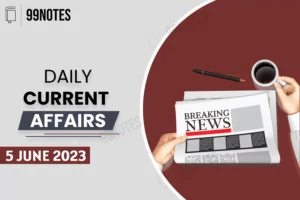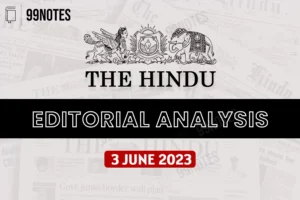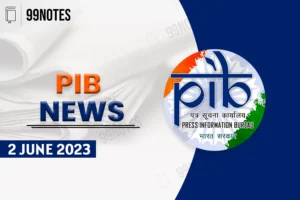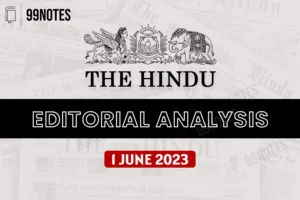5 June 2023 : Daily Current Affairs
DAILY CURRENT AFFAIRS
- DAILY CURRENT AFFAIRS
- 1. Himachal and Punjab appear set for face-off over Shanan power project
- 2. Understanding the Kavach system
- 3. Why does North Korea want spy satellites?
- 4. How the reification of caste will not lead to a true politics of change and justice
- 5. Refugee influx into Mizoram raises security issue in State.
- 6. Arunachal scraps 44 hydel deals with private players.
- 7. ‘Quick-win’ reforms can spur economy this year: CII chief
- 8. How genome sequences tracked down an ancient disease
- 9. Evapotranspiration: first part of a cycle moving water from terrestrial surfaces to the air.
- For Enquiry
5-June-2023
Daily Current Affairs For UPSC ,Daily Current affairs of The hIndu and Indian Express.
1. Himachal and Punjab appear set for face-off over Shanan power project
Topic: GS2 – Inter-state relations.
Context:
-
-
-
The 99-year lease on the Shanan hydropower project in Jogindernagar, Mandi district of Himachal Pradesh, controlled by the Punjab government, will expire in March 2024.
-
-
Issue:
-
-
-
Himachal Pradesh has stated that it will not renew or extend the lease and wants the project to be handed over to the state.
-
Punjab is determined to retain the project and is willing to take legal action to do so.
-
Himachal Pradesh Chief Minister Sukhvinder Singh Sukhu has written to the Punjab Chief Minister informing him of the lease expiration and the state’s intention to take over the project.
-
Himachal Pradesh has sought the intervention of the Union Minister for Power to issue necessary directions to Punjab for handing over the project before the lease expires.
-
Punjab maintains that it is in continuous ownership and possession of the project and may consider legal action if necessary.
-
The Shanan power project was conceived in 1922 and the first stage was commissioned in 1932 under a lease agreement executed in 1925.
-
-
2. Understanding the Kavach system
Topic: GS3 – Railways – security.
Context:
-
-
-
A train accident at Bahanaga Bazaar railway station in Odisha’s Balasore district resulted in the tragic death of over 288 passengers on June 2. This incident has highlighted the urgent need for effective safety mechanisms to prevent such tragedies in the future.
-
-
Issue:
-
-
-
KAVACH is an Automatic Train Protection (ATP) system developed by the Research Design and Standards Organisation (RDSO) in collaboration with the Indian industry.
-
It is designed to prevent trains from passing signals at Red and avoid collisions, activating the braking system automatically if the driver fails to control the train as per speed restrictions.
-
KAVACH also prevents collisions between two locomotives equipped with the system and relays emergency messages.
-
The system includes a centralised live monitoring of train movements through the Network Monitor System.
-
It uses Traffic Collision Avoidance System (TCAS) and Radio Frequency Identification (RFID) tags for two-way communication between the station master and loco-pilot.
-
KAVACH has been implemented on the South Central Railway (SCR) Zone, covering 1,465 km in 77 locomotives and 135 stations.
-
The Kavach deployment strategy prioritizes High Density Routes, such as the New Delhi-Mumbai and New Delhi-Howrah sections, to address the higher chances of accidents.
-
Three firms (Medha Servo Drives, HBL, and Kernex) have been approved by the RDSO to provide Kavach equipment, with more in the pipeline.
-
Vulnerabilities and challenges, such as closed level crossings, stray cattle or boulders on tracks, and communication issues, have been addressed in the system.
-
-
3. Why does North Korea want spy satellites?
Topic: GS3 – International space developments.
Context:
-
-
-
On May 31, North Korea launched the Malligyong-1 satellite using the Chollima-1 rocket, but it crashed into the Yellow Sea after about 10 minutes of flight.
-
The launch was deemed a failure due to instability in the rocket’s engine and fuel system, according to the Korean Central News Agency.
-
-
Issue:
-
-
-
The North Korean space program is closely linked to its missile program, as satellite launch vehicles use similar technology to long-range missiles.
-
North Korea aims to acquire assets in space for advanced surveillance capabilities, enhancing its ability to strike targets during conflicts.
-
The launch of the Malligyong-1 satellite prompted evacuation warnings and emergency alerts in parts of South Korea and Japan.
-
The United States, Japan, and South Korea expressed strong condemnation of the launch.
-
North Korea’s space program is a response to regional developments, including the activation of U.S. Space Forces Korea and South Korea’s own efforts to develop a space-based surveillance system.
-
The launch highlights the security concerns in East Asia and the urgency among regional powers.
-
It is unlikely that the launch will result in additional economic sanctions against North Korea, indicating the weak effectiveness of current sanctions.
-
A successful set of military satellites by North Korea would significantly enhance its surveillance and missile-launch capabilities in the region.
-
-
4. How the reification of caste will not lead to a true politics of change and justice
Topic: GS1 – Indian society.
Context:
-
-
-
The movie Kathal demonstrates the process of reification by accepting and perpetuating caste stereotypes, thereby reinforcing the hierarchical caste system.
-
-
Issue:
-
-
-
Reification is the turning of an abstract concept into a fixed belief, and it is a result of socio-economic processes.
-
Georg Lukacs developed the concept of reification in his work History and Class Consciousness, explaining its influence on the legal system in capitalist societies.
-
Reification leads to the alienation of individuals and their acceptance of a mechanistic existence within capitalist structures.
-
Andrew Feenberg argues that class consciousness and the realization of one’s labor conflict are necessary for de-reification and the potential for revolutionary transformation.
-
Axel Honneth suggests that reification is also a result of the lack of recognition from others, leading to the devaluation of the self.
-
In India, the caste system is the dominant social structure, with an endogamous nature and a graded hierarchy of privileges and disadvantages.
-
Marginalized groups mobilize around their caste identity to counter upper caste hegemony, which represents the paradox of caste.
-
While identity politics based on caste solidarity can be emancipatory, it also reinforces caste and limits the potential for the annihilation of caste.
-
Reification alone cannot bring about true revolutionary change and justice.
-
-
5. Refugee influx into Mizoram raises security issue in State.
Topic: GS3 – internal security, Migration..
Context:
-
-
-
Mizoram has experienced an influx of refugees from Myanmar, Bangladesh, and Manipur, contributing to the internal security situation.
-
-
Issue:
-
-
-
The exact number of refugees from Myanmar varies between the State government and security forces, with estimates ranging from 30,000 to 18,000 individuals.
-
While the State government has set up camps for the refugees, many have chosen to stay with relatives or seek employment elsewhere.
-
There are concerns about the potential for smuggling narcotics and weapons, particularly with the influx of refugees from Bangladesh, posing a new security challenge.
-
Security forces, including three Assam Rifles Battalions, are monitoring the situation along the India-Myanmar Border (IMB).
-
The IMB region has seen increased seizures of narcotics, with the total value of seized narcotics in Mizoram rising from ₹355 crore in 2022 to ₹603.43 crore in the current year.
-
The imposition of martial law by Myanmar’s military junta and recent air strikes near the IMB have added to tensions in the border areas.
-
The influx of refugees is exacerbating resource shortages and could potentially lead to unrest among the local population in south Mizoram.
-
Concerns have been raised about the possibility of smuggling arms and narcotics due to the difficult terrain and the presence of individuals guiding the refugees.
-
Assam Rifles had highlighted security issues, but no significant action has been taken so far.
-
-
6. Arunachal scraps 44 hydel deals with private players.
Topic: GS3 – Energy sector.
Context:
-
-
-
The Arunachal Pradesh government has canceled 44 hydroelectric power deals with private developers who showed no interest in executing them.
-
-
Issue:
-
-
-
The withdrawn projects have a total installed capacity of 32,415 megawatts and will be handed over to Central Public Sector Undertakings (CPSUs) through new agreements.
-
The agreements for 44 projects were terminated as the private developers did not show any interest in executing the projects despite multiple notices served.
-
Fresh agreements have already been signed for nine of the 44 projects, with an installed capacity of 1,300 MW, and the remaining projects will be processed soon.
-
CPSUs such as the National Hydroelectric Power Corporation and Tehri Hydro Development Corporation Ltd. have evaluated an indicative list of 29 projects prepared by the central government.
-
-
7. ‘Quick-win’ reforms can spur economy this year: CII chief
Topic: GS3 – Indian economy.
Context:
-
-
-
R. Dinesh, President of the Confederation of Indian Industry (CII), believes that there is an opportunity for “quick-win” reforms to boost the Indian economy amid the ongoing election year.
-
-
Issue:
-
-
-
President of CII suggests expanding global trade ties and facilitating investments from pension funds and insurers as potential quick-win reforms.
-
Dinesh acknowledges that more significant changes such as rationalizing the Goods and Services Tax (GST) and addressing outdated factor market laws may have to wait until after 2024.
-
He highlights high capacity utilization rates in various industries, including steel, cement, chemicals, hotels, and aviation, indicating a positive outlook for the private sector.
-
Dinesh emphasizes the importance of making growth capital more easily accessible from domestic banks and overseas investors.
-
He suggests reviewing import tariffs and engaging in free trade agreements (FTAs) to attract more investments and integrate with global value chains.
-
The CII president hopes for a shift in the Reserve Bank of India’s stance from “hawkish” to “neutral” in the monetary policy review, which would help boost investor confidence.
-
Dinesh expects a possible rate reduction in the future if inflation remains stable and favorable conditions persist until October or December.
-
-
8. How genome sequences tracked down an ancient disease
Topic: GS3 – Science and technology.
Issue:
-
-
-
The ‘Black Death’ was one of the deadliest epidemics in human history during the 14th century, caused by the bacterium Yersinia pestis.
-
The outbreak of the ‘Black Death’ resulted in the death of millions of people in Europe, with some major cities losing 40-50% of their population.
-
India has also experienced plague epidemics, with outbreaks occurring in various regions since 1896.
-
The study of historical disease outbreaks, including the ‘Black Death,’ provides insights into the impact of infectious diseases on society, economy, and culture.
-
Advances in genome sequencing technologies have allowed scientists to trace the evolution and adaptation of human pathogens, including Yersinia pestis.
-
Deep sequencing of genetic material from well-preserved human remains has revealed information about the genetic makeup of ancient pathogens.
-
Recent studies have identified Yersinia pestis genomes lacking certain genes associated with the bacterium’s ability to cause infections and be transmitted through fleas.
-
The presence of functional genes in ancient Yersinia pestis genomes suggests the bacterium’s ability to be toxic to fleas.
-
Genome sequencing has also expanded to include studies of animal and plant diseases, contributing to a comprehensive understanding of overall health (One Health approach).
-
-
9. Evapotranspiration: first part of a cycle moving water from terrestrial surfaces to the air.
Topic: GS3 – environment and ecology.
Issue:
-
-
-
Evapotranspiration is a movement of water from terrestrial surfaces into the atmosphere as part of the water cycle.
-
It is a combination of evaporation (water loss from the soil) and transpiration (water loss from plants).
-
Factors such as solar radiation, day length, soil moisture, temperature, winds, and water vapor in the air affect the rate of evapotranspiration.
-
The term was first published in hyphenated form and defined by climatologist Charles Warren Thornthwaite in 1944.
-
Evapotranspiration is important for farmers as it helps them estimate the water needs of their crops.
-
-
For Enquiry

5 June 2023 : Daily Current Affairs

3 June 2023 : PIB

3 June 2023 : The Hindu Editorial

3 June 2023 : Daily Current Affairs

2 June 2023 : PIB

2 June 2023 : The Hindu Editorial

2 Jun2 2023 : Daily Current Affairs

1 June 2023 : PIB

1 June 2023 : The Hindu Editorial

1 June 2023 : Daily Current Affairs
Daily Current Affairs 5 June 2023 : Daily Current Affairs The Hindu Editorial
12-May-2023
Daily Current Affairs For UPSC ,The Hindu Editorial Summary
Facebook-f
Twitter
Youtube
1.Marriage…
PIB 3 June 2023 : PIB PRESS INFORMATION BUREAU
3-June-2023
Daily Current Affairs For UPSC ,The PIB ( Press Information Bureau…
The Hindu 3 June 2023 : The Hindu Editorial The Hindu Editorial
3-June-2023
Daily Current Affairs For UPSC ,The Hindu Editorial Summary
Facebook-f
Twitter
Youtube…
Daily Current Affairs 3 June 2023 : Daily Current Affairs DAILY CURRENT AFFAIRS
3-June-2023
Daily Current Affairs For UPSC ,Daily Current affairs of The hIndu…
PIB 2 June 2023 : PIB PRESS INFORMATION BUREAU
2-June-2023
Daily Current Affairs For UPSC ,The PIB ( Press Information Bureau…
The Hindu 2 June 2023 : The Hindu Editorial The Hindu Editorial
2-June-2023
Daily Current Affairs For UPSC ,The Hindu Editorial Summary
Facebook-f
Twitter
Youtube…
Daily Current Affairs 2 Jun2 2023 : Daily Current Affairs DAILY CURRENT AFFAIRS
2-June-2023
Daily Current Affairs For UPSC ,Daily Current affairs of The hIndu…
PIB 1 June 2023 : PIB PRESS INFORMATION BUREAU
1-June-2023
Daily Current Affairs For UPSC ,The PIB ( Press Information Bureau…
The Hindu 1 June 2023 : The Hindu Editorial The Hindu Editorial
1-June-2023
Daily Current Affairs For UPSC ,The Hindu Editorial Summary
Facebook-f
Twitter
Youtube…
Daily Current Affairs 1 June 2023 : Daily Current Affairs DAILY CURRENT AFFAIRS
1-June-2023
Daily Current Affairs For UPSC ,Daily Current affairs of The hIndu…





